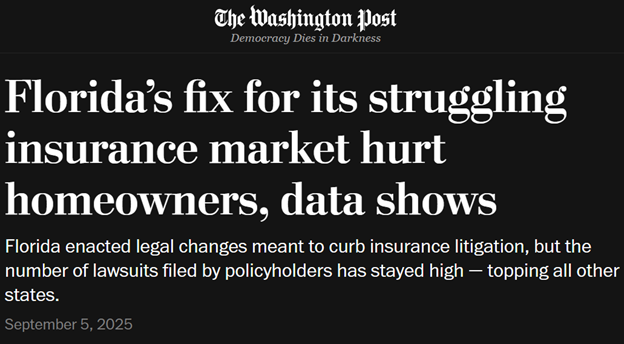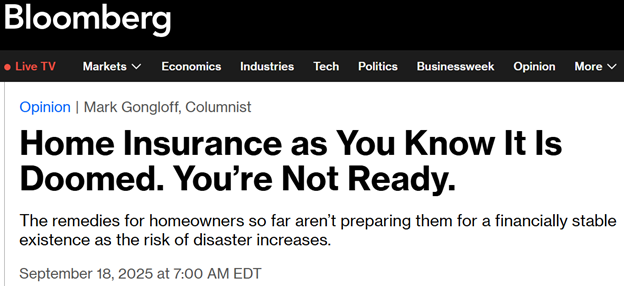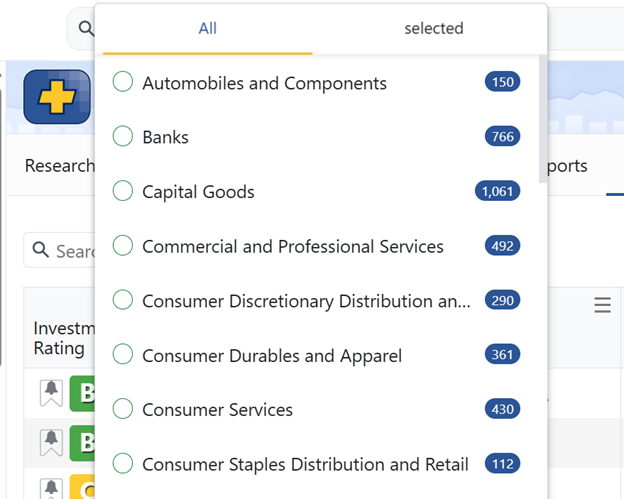When the Fed announces rate cuts, Wall Street usually celebrates.
That’s because lower interest rates can signal help is on the way. For the economy and — perhaps especially —for stocks.
Over the 100 trading days following a September Fed cut, the S&P 500 gained an average of 8.5% over the past 25 years.
Just since Sept. 17, the broad-based index is already up some 1%. But this isn't a victory lap for inflation control. Nor a sign the economy is humming along.
Rather, this time around seems like a desperate pivot … a signal that the Fed has run out of good options as:
- Debt continues to spiral.
- The real economy is stalled or weakening.
- Inflation remains sticky beneath the surface. (You know how much you are paying compared to last year.)
In other words, the Fed isn’t cutting rates because it wants to. Jerome Powell is lowering rates because the Fed simply has no other option.
This pivot tells us the financial system is under pressure — and the traditional playbook won’t work this time.
That doesn’t mean you’re powerless.
In fact, the Fed is handing you a clear opportunity to get ahead of the next rotation in stocks, if you know where to look.
Fortunately, you have exactly the tools to help you do just that.
Wall Street Exploits Rate Cuts. Here’s How You Can, Too.
Every time the Fed pivots, institutional capital starts to move before the headlines.
Wall Street doesn’t wait for Powell’s press conference — it watches bond spreads, dividend spreads and momentum flows.
When those signals start to turn, the money follows.
That money has been flowing heavily into familiar territory:
- High-yield dividend stocks.
- Utilities with pricing power.
- Precious metals and miners.
These sectors have consistently outperformed in past rate-cut cycles. And just like clockwork, they’re starting to move again.
You can see the evidence in our Wall Street’s Hidden “Buy” Signals screener. There, you can see stocks that have earned fresh new “A” and “B” ratings in the past several days.
History suggests select sectors and stocks should go higher as rate cuts go lower.
But there are exceptions.
What Not to Target This Cycle
In a typical cycle, regional banks and Real Estate Investment Trusts tend to rally as lower rates boost refinancing and lending activity.
But that’s not happening this time.
- The SPDR Regional Banking ETF (KRE, “C-”), is down some 2.5% since rate-cut day.
- The iShares Real Estate ETF (IYR, “C”), has been flat since July.
This isn’t how leadership sectors behave during a rate-cut cycle.
Which is why:
- I’m watching your Wall Street’s Danger Zone: Real-Time Stocks Just Downgraded to “Sell” screener closely.
- I check that list daily, along with your Sell Alert: 5 Popular Stocks You Should Avoid Like the Plague.
Both lists show stocks newly rated “D” or lower.
You may want to sell any of your stocks that wind up on those lists. Or ones in danger of end up on either of those lists because their ratings and/or prices are falling.
(Did you know: You can get instant alerts when a rating changes. Go to your Tutorial Videos tab and scroll down to “How Do I Set up Alerts?” You can also tell us to alert you when a price changes by a certain amount, too!)
If regionals and REITs are losing money, what sectors are getting a boost?
Based on what we see in the ratings, here’s …
Where the Smart Money Is Moving
These are the areas flashing early green in the Weiss Ratings:
- High-dividend stocks with strong momentum and low risk.
- Utilities with predictable earnings and defensive strength.
- Metals and miners, where monetary debasement risk meets scarcity.
And the only way to get ahead of the next major move is to follow the signals, not the sentiment.
Here’s the secret: You don’t need to trust Jerome Powell. You just need to trust the data.
Wall Street insiders track capital flows, credit markets and high-frequency earnings trends.
You can do all that … and all in one place … with your current Weiss membership.
Weiss Ratings Plus can help you spot the same directional shifts — with none of the guesswork.
Weiss Ratings Plus is built to cut through the noise. It:
- Highlights high-Weiss-rated stocks in utilities, dividend income, metals and more.
- Flags rising momentum, low-volatility and even undervalued outperformers.
- And includes tools like the Dividend Screener, which regularly surfaces new opportunities backed by strong fundamentals.
In fact, during our editorial review, one longtime Weiss team member flagged Rithm Capital (RITM, “B”) as a standout example of the kind of income opportunity emerging in this environment.
It’s not an official recommendation — just a signal that the best opportunities are often hiding in plain sight.
Want to See More?
For this month’s new release, we built a new Utility Stock Screener and Gold Stock Screener.
The screeners are now live just for Weiss Ratings Plus members.
With one click, you can drill down to the strongest names in each group.
As for what the smart money is buying in today’s hottest sectors, we have that for you, too.
The Rate-Cut Strategy:
Build Your Anti-Fed Portfolio
Forget portfolio models and cookie-cutter allocations.
Instead, here’s what smart money is already doing, and how you can start doing the same today:
These are great examples of the kinds of companies that are already flashing green in Weiss Ratings as the Fed’s “forced” interest-rate cycle begins.
These stocks — RITM, American Electric Power (AEP, “B”), Franco-Nevada (FNV, “B-”), Main Street Capital (MAIN, “B”) and Southern Copper (SCCO, “B-”) — display some desirable characteristics for this moment in time.
Qualities like high income potential, low volatility and early momentum.
Want more ideas like this? Consider starting with your Ultimate Dividend Power List screener.
As for what not to buy, we just talked about REITs and regional banks as sectors to sidestep …
And with Ratings Plus, you can see exactly which stocks to avoid.
Your Stock Ratings Analyst tool lets you filter by Industry.
Go to that page, click on the funnel icon and you can choose sectors to target.
If you click on Banks, that will take you to our INVESTMENT ratings for banks.
We also have SAFETY ratings for banks.
- The investment ratings can help you see which bank stocks are “Buys” or “Sells.”
- The safety ratings can help you, as a consumer, decide which banks you do (or don’t) want to do business with.
Only Weiss Ratings Plus members can see The Weakest & Strongest Banks: How Safe Is Your Bank? with just one click.
Lower interest rates can be good for banks in that they can borrow money cheaper.
This can improve their bottom line … and their stock price.
Especially if they don’t pass the cost savings along to you, the consumer.
As a saver, there is one thing you can count on …
With every cut, more money comes out of your pocket. The average savings account in the U.S. already only pays a paltry 0.59%.
So it’s important to find other ways to build capital.
That’s through capital appreciation … dividends where applicable … and housing your nest egg at strong financial institutions that are in no danger of going belly-up.
That’s why you’re in the right place with Weiss … and at the best possible time, too.
How Ratings+ Helps You See
Past the Smile & the Spin
The Fed’s job is not to protect your wealth.
Its job is to manage systemic risk and make sure the headlines don’t spark panic.
That’s why Powell’s rate cuts come with a smile and a spin.
But behind the curtain, trillions of dollars are being repositioned by the institutions that know what’s really happening.
Meanwhile, Weiss Ratings doesn’t follow the Fed’s narrative.
It follows the numbers — fundamental strength, risk signals, dividend sustainability and price momentum.
Powell has telegraphed that more rate cuts are coming.
Which means the rotation we see already — almost 10 trading days after the first rate cut — is only the beginning.
There will be many more opportunities to build a smarter portfolio in the coming months …
Along with many more new releases to help you take advantage of them.
And the only place where you can conveniently find them all together is right here in Weiss Ratings Plus.
Weiss in the News
A few moments ago, we talked about Weiss’ safety ratings for banks.
We also have those for insurance companies.
And Dr. Martin Weiss is consistently sought out by the media to comment on our research about insurers.
Especially property and casualty insurers.

From the article:
“Last month, three days after The Post reached out to industry representatives about the data compiled by Weiss, state regulators proposed a rule that would require insurance companies to submit more detailed information about their litigation and property insurance disputes than had previously been required — though some of those demands had already existed since 2021.”
And this Bloomberg Opinion piece also cited this research and quoted Martin.

From the article:
“When they say the market is healthier because they’re bringing in more insurers, you’ve got to look at the status and capitalization of those insurers,” Martin Weiss, founder of Weiss Ratings, an insurance ratings company, said in the webinar.
“They’re often small, under-capitalized, fly-by-night companies, making the state less healthy, weaker, and more vulnerable to bankruptcies.”
These articles are worth a read in their entirety. You can see how passionate Martin is about helping consumers as well as investors.
We all are. Which is why we welcome your feedback about how Weiss Ratings Plus is working for you in the real world. My inbox is open 24/7. I look forward to hearing from you.
To your success,
Dallas Brown
Publisher
P.S. Gold is up more than 45% this year. That’s important to know, because gold prices have historically led Bitcoin’s by about six months.
And now, Juan Villaverde says a major crypto market “Buy” opportunity approaches in late October.
He’s going live this coming Tuesday, Oct. 7 at 2 p.m. Eastern to reveal the exact date.
His Timing Model precisely called Bitcoin's Election Day surge from $69K to $106K … the April 7 surge from $75K to record highs … and more.
Now, his AI-enhanced model 2.0 system reveals an even stronger opportunity ahead… one where a handful of other cryptos are likely to do even better this time around.
See how this breakthrough could help investors milk huge windfalls from the crypto market.



